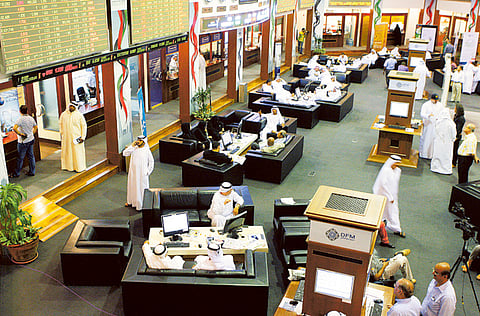Despite upgrade, UAE and Qatar markets still considered risky
Markets in two countries seen as risky due to volatility, difficulty in access

Abu Dhabi: Despite their recent upgrade to the emerging market status, the UAE and Qatar are considered risky by many investors and analysts, with one analyst citing the Dubai Financial Market (DFM) as the riskiest in the Arab world.
This has long been attributed to the market volatility, and the ability of certain stocks to control the index and drastically affect its movement. The most notable stock on DFM is Arabtec, which was suspended from trade on Thursday due to ambiguity on its share ownership.
Investors also fear difficulties in accessing the market, and political unrest in the Middle East, which sometimes affects trade of certain stocks.
The UAE and Qatar bourses climbed steeply over the past year, as many investors took the opportunity to buy shares in anticipation for the upcoming upgrade in May, which was expected to raise prices.
In June, however, the markets fell sharply, leading many investors to losses.
Osama Al Ashry, a member of UK organisation, Society of Technical Analysts, discussed the DFM’s performance on Thursday saying that there was real purchasing power as investors were no longer focused on one main stock — Arabtec.
“I think Gulf Finance House (GFH) will now be the new number one player on DFM. It has been accounting for 20 to 30 per cent of the total trade value in the past few sessions, and it just reached its highest price yet, which means that next week will see new highs,” he said.
Historical downtrend
Al Ashry added that the GFH share price has targets between Dh0.69 and Dh0.73 on the short to medium term. If this price level is broken, the new resistance level will be at least Dh1 in the next two months or so.
As for the index, the analyst said it is trading in a historical downtrend, which can only be broken if it reaches a resistance level of 5,289.
While Al Ashry said the Abu Dhabi Securities Exchange (ADX) index was also experiencing a historical downtrend, he said the index movement is not as steep as that of the DFM, and thus, the capital’s market has better potential.
Meanwhile, Qatar’s bourse added 0.84 per cent to close on Thursday at 13,284.65 largely on the bank of Islamic lender, Masraf Al Rayan, which gained 1.69 per cent.
Across the borders, markets weren’t very different as the Saudi benchmark index is trading in a downtrend, closing at 9,786 on Thursday.
“The Saudi market hasn’t reached such levels since January 2008. I think in the next few weeks, the index can easily reach a resistance level above 10,000, which gives a positive outlook on the short and medium term, but I think the long-term outlook is negative,” Al Ashry said.
Though the Saudi market was not part of the MSCI upgrade, the market appears to attract similar investors to the UAE and Qatar, and thus, presents itself as a competitor.
Performance
Saudi Arabia’s market capitalisation of more than $500 billion (Dh1.8 trillion) is larger than the UAE and Qatar combined, meaning that any opening up could take Saudi Arabia to the emerging index.
Looking into the market performance, the insurance sector appears to be the most active, albeit its weak effect on the index. The petrochemicals industry, along with the banking, and real estate sectors, though, dominate over the index movement.
In Kuwait, the market closed at 7,097 on Thursday — a 0.21 per cent drop. Gulf Finance House, which is also listed in Kuwait, showed signs of strong trade as it accounted for over 12 per cent of the total value of trade.
Al Ashry commented on the Kuwaiti market saying, “Trade is not positive, but it’s not risky either. The index has a strong support level at 6,780.”
With inputs from Reuters
Sign up for the Daily Briefing
Get the latest news and updates straight to your inbox



